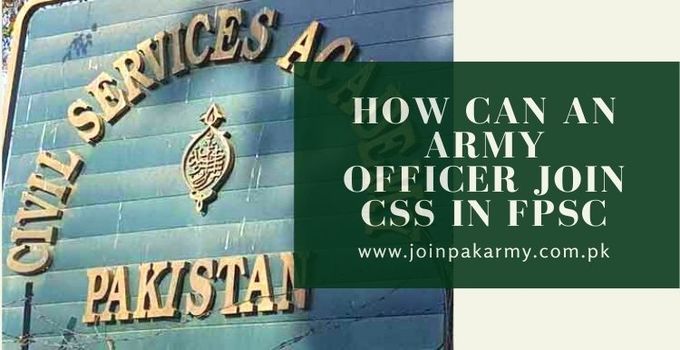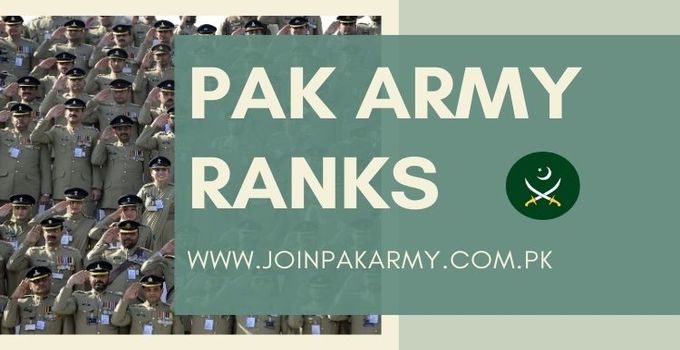Thinking about how an Army Officer can join CSS in FPSC, so this is the best place for you. Let’s start with Information about CSS. The CSS is a permanent bureaucrat elite, and the public sector responsible for the administration of civil bureaucracy, government secretariats, and cabinet directorates. The Central Superior Services (CSS or Bureaucracy) of all civil service affairs, the Prime Minister is the sole authority.
Just 7.5% of candidates are chosen by Merit, education, qualification, and expertise by the Pakistani civil service, while the quota system selects 92.5%. The civil service examinations are challenging and, based on their credentials, give men and women equal opportunity. At the beginning of each year, the CSS tests take place. The Federal Civil Service Commission performs and supervises the tests. In 2015, only 3% of the 12,176 participants cleared the multi-stage examination, reputed to be a fragile pass rate.
How to Join CSS in FPSC (Procedure)
The CSS test takes place periodically and is attended by many individuals. This examination’s reputation and quality are demanding and require thorough and lasting planning. The test will be conducted for officers in 17th grade in United Grades of all Pakistan up to 22nd grade.
The officers are split into 12 groups: Commerce & Trade, Customs and Excise Department, District Management Group, Pakistan’s Foreign Service, Income Tax Group, Military Land and Cantonments, Office Management, Pakistan Audit, and Accounting Service, Pakistan Police Service, the Post, and Trail Group. Candidates must be at least 21, and at most 28, to take the test and must have at least a second-class degree or international certification in Pakistan.
Read Also:- NUST Entry Test
Job Distribution
The job distribution of successful candidates shall be based on Merit and quotas in the provinces and regions. They are Merit (7.5%), Punjab (and Islamabad Capital City included), (50%), Sindh (11.4%), Sindh (urban) (7.6%), Khyber-Pakhtunkhwa (11.5%), Balochistan (6%), Gilgit-Baltistan and FATA (4%), Azad Jammu, Kashmir and others (2 percent).
The percentage of women has a 10% quota, and the proportion of minorities has a five% quota, minus the merit quota. The test takes place concurrently in Islamabad, Lahore, Karachi, Peshawar, Quetta, Multan, Faisalabad, Gujranwala, Hyderabad, Sukkur, Abbottabad, D I Khan, Skardu, and Muzaffarabad.
CSS Exam
The review consists of a written segment composed of six mandatory and six optional subjects with a total of 1200 marks and a psychological evaluation with a speech with a voice of 300 characters. The typical combination for the test is 50%. When passed, the Federal Public Service Commission (FPSC), the regulatory body responsible for this study, picks you from the categories according to your place of Merit, provincial quota, and suitability criteria.
The written examination usually takes place every year in February, and reports are collected in or near September. The interpersonal review, a living voice, and a surgical test follow.
The applicants chosen are probe officers, followed by departmental training at the Academy of Civil Service in Lahore.
The general tendency is that social science is identical to those of the topics of the necessity to be discussed in philosophy, politics, public policy, and foreign affairs. The questions put are commensurate with the degree, as graduates qualify to take the test. Candidates must respond in English, while in Urdu, the Islamiat paper can also be referred to.
Army Officers Quota
The army officers join CSS in FPSC have a set quota (Military become civil bureaucracy) Some laws refer to military officers who are part of the civil bureaucracy (officer only). The following are:
- A quota system is required for them. For the military, 10% was allocated.
- Only in 3 classes can be distributed: POLICE SERVICE OF PAKISTAN(PSP), DMG, and FOREIGN SERVICES.
- They may only be interviewed in compliance with laws. You don’t take an exam in the literature (They skip it).
- The military officers may enjoy this right. These officers may, however, be used and joined in secondment by Civil bureaucracy. This second is further relief.
Army Officers Enter the civil services employing a lateral entry clause initially crafted by Mr. Bhutto, which he and his predecessors, in particular, Mr. Zia Ul Haq, have extensively exploited. They have a limit of just 10 percent, but only three systems, i.e., FSP, DMG, PSP. The interviews are carried out at the GHQ only, followed by a personality examination and an FPSC interview.
There are particular benefits under which they leave the public sector’s armed forces, esp. (CSS).
Two scenarios are available:
- For fear of brain drain, the top 20 officers shall not move to any path other than serving and thriving in the military; the remaining lot can be applied for by public service by laterally or general recruiting.
- Officials living either in Sindh Tribal, FATA, Baluchistan or AJK, etc. Typically, when there’s not a competition, a seat is comfortable. The Punjab officers have direct expertise or intercession (PAWA as is popularly termed).
Lateral Entry
In the beginning, the rule of “Lateral Entry’ was not defined or inducted by the Army General’s constitution. It was carried out by the most famous constitutionally elected Prime Minister, Mr. Bhutto.
Second, because military officers enter the military service at 17th grade and stay in 17th grade until they join the civil servant (unless promoted at 18th grade), they are considered senior to the newly named applicants owing to service according to the laws of seniority and promotion in 1990. However, this is not the case for an officer who enters the military service after retirement.
Similarly, a man in the Government (Civil) department in grade 17 will also obtain a seniority fix in compliance with the above-noted laws. However, it’s infrequent. You can find these cases only when you see, for example, a civil bureaucrat qualifying the CSS to boost his service community once again.
Read: Join Pak Army
Eligibility Criteria
Here is the Criteria for eligibility of Pakistan Army membership in the 144th Long Course as a commissioned officer.
- The dual Pakistani people must be Pakistani male citizens (for fighting roles), but the second nationality has to be surrendered if the Army chooses you before entering PMA Kakul.
- Maximum age 17-22, if appropriate, for a few months’ rest.
- Education: 12 years Bachelor of Education, with 60% points. Education: 12 years FATA, Baluchistan, and rural Sindh candidates will apply at 45% – 55%. Often in underdeveloped countries, age relaxation applies.
- Height: 5.”
- BMI weight 5:
- To qualify for the ISSB, the initial examination must be cleared.
- The ISSB covers scholarly, psychometric, intellectual, physical, medical, and a detailed interview.
- The study cycle at the PMA, along with a bachelor’s degree, is two years.
- Good graduates are being named Second Lieutenant in the Pakistan Army.
Conclusion
Finally, you get to know everything about How can an army officer join CSS in FPSC. The spirit to serve one’s country is always real, and it takes a lot of struggle. Read the complete article and let us know how likely you find it. Best Regards!


![PMA Long Course 2024 [Eligibility Criteria & Selection Procedure] PMA Long Course 2024 [Eligibility Criteria & Selection Procedure]](https://pakarmyranks.com/wp-content/uploads/2021/04/PMA-Long-Course.jpg)

Assalamualaikum
I need information about how to join the Pakistann Army I’m 16 right now soon 17 I’m currently in college studying I’m a Spanish national but background Pakistani and I’m living in the UK
Please send me information
Thanks
Kind regards
For joining of pak army as a commissioned officer you must go through ISSB 4 days testing programme which includes initial,physical,group disscussion and final interview further more you can watch eligibility criteria on google the successful candidate is called fort two years training in PMA PAKISTAN MILITARY ACADEMY in Kakul Abbottabad.After which you have given rank of 2nd lieutenant.
Assalam_o_Alikum! Please guide me which level of degree will be issued to me if I am being selected for air defense after clearing ISSB at intermediate level. After three years of training, Is that degree is enough for CSS or not? Can I try for CSS after becoming air defense officer at intermediate level. Please guide me
Can a married girl can apply in army as a doctor and then go for CSS. Is it possible
Aoa…
Kindly tell me if a person is 26 years of age and he is recruited to Pak army as Captain. After 7 years of bond in military, his age would be 33, and at this age he wants to join civil bureaucracy. So the question is, can he join the css then at the age of 33?
Aslam o Alaikum I m doing bachelor physics fourth semester is this possible that I can join Pka army or air force in between my bachelor I m a girl